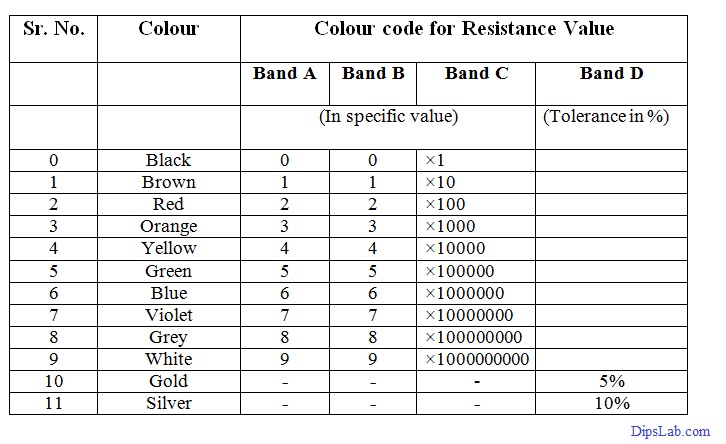
In a previous article, we have seen the basics information about resistors with their colour bands.
Each resistor has a specific resistance value as per designing colour band. And it depends upon the colour code/band printed on the resistor.
Before using any resistor in an electronic circuit, you need to find out the first resistance value of the resistor.
Let’s see in details,
How to calculate Resistance using colour code?
The colour bands on the resistor are used to identify the value and tolerance or resistance.
The power rating of the resistor depends upon the physical size of the resistor.
We consider as, a resistor consists of four different color bands (A, B, C, and D printed on the resistor body) as shown in the below figure.

The first of three different colour band (A, B, C) shows a different value of resistance. And the last band (D) shows the tolerance of resistance in percentage.
Firstly, you should refer the resistor colour band table given below.

Note: I know, it is not easy to remember the value corresponding to each color band. You can use this simple phrase to remember the sequence color band and its values.
BB ROY of Great Britain had a Very Good Wife.
Here, each band position and its colour has specific significance to calculate resistance value.
Band A: A first colour band (A) represents the first digit of the numerical value of the resistance. (Says x)
Band B: The second colour band (B) represents the second digit of the numerical value of resistance. (Says y)
Band C: Third colour band (C) is the decimal multiplier and gives the number of zero after two digits. (Says z)
Band D: The fourth band (D) or last band shows the tolerance in percentage (%). (Says p)
So the final formula you can use to calculate resistance:
Resistance = ((10x + y) z) (p/100) (Unit- Ohm)
Example of Resistor Colour Code:
Consider, a resistor is having four different colour bands red, brown, orange, and gold respectively as shown in the below diagram.

Firstly choose the value of colour from the table.
| Red | Brown | Orange | Gold |
| 2 | 1 | 1000 | 5% |
First Step:
The Red band of the resistance value is 2 and the brown band of the resistance value is 1 from the table.
The first two digits of the band show the value of resistance 2 and 1 i.e. 21
Second Step:
From the table, the third orange band has value 1000. Multiply this value to 21 i.e. 21×1000=21000 Ω.
Third Step:
Last is the Gold band having tolerance value in 5% (0.05) from the table. The 5% tolerance resistor may have a maximum and minimum value of resistance.
- for maximum resistance value, 21kΩ or 21000Ω + 5% = 22,050Ω
- for manimum resistance value, 21kΩ or 21000Ω – 5% = 19,950Ω
Finally, we get the final value of resistance is in the range of 22,050 to 19,950 Ω.
Once you know to calculate resistance using colour Code of resistors, it will be easy for you to design and using resistors in the electronics circuit.
If you have any queries, you can hit the comment in given comment.
Electrical Related Read:
- Resistance vs Reactance
- Resistance vs Reluctance
- Electrical vs Electronics
- Alternating vs Direct Current
- Electrical Measuring Instrument
- Basic Electric Circuit Concept
Thanks for Reading!
Informative article.
Thanks, Viraj 🙂
useful information in jee point of view .
Thanks, Harsh.
Thanks for your a simple way teach.
You’re welcome 🙂